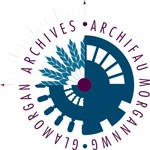This is the third in a series of articles on the building and opening, in September 1883, of the Glamorganshire and Monmouthshire Infirmary and Dispensary. It draws on records held at Glamorgan Archives.

It was little more than 8 months from the laying of the memorial stone to the arrival of the first patients at the new hospital. The number of in-patients at the old infirmary had been steadily reduced during September 1883 to ease the transfer. By 24th September only 9 remained, mostly those with serious fractures. The move to the new premises had begun on Thursday 20th September, with the in-patients to be moved on the following Tuesday. Bad weather, however, forced a delay. It was not until Wednesday 26th that they were transferred, one at a time, under the supervision of Matron Pratt, by a team from the St John’s Ambulance Society. For the short journey along Newport Road each patient was placed in an ambulance ‘cart’ which could be dismantled and carried into the hospital.
The new hospital was heralded as …unequalled by any in the Principality … and as near perfect as it could be. Yet, in September, many areas were still under construction, including the grand frontage with its 80 foot central tower. The two main ward blocks and the kitchen and laundry were, however, complete. It was just as well that the initial number of patients was low. The staff, including the House Surgeon, P Rhys Griffiths, Matron Pratt, nurses and porters were expected to live on the premises. They also had to live and sleep in one of the wards until their accommodation, in the main wing facing on to Glossop Road, was finished.
It was not all bad news. The new wards had been designed and equipped in line with the very best hospitals in Britain at the time. Each of the two new ward blocks had two floors. On each floor there was one large ward with beds for 20 patients and three small side wards. There was also a small kitchen and a linen room. To ensure that patients had ample fresh air, at one end of the large ward there was a day room with large bay windows that could be thrown open. Patients on the ground floor had access to an outside terrace that ran the length of the ward. The architects were particularly proud of the sanitary arrangements, described as …most effective and complete. In practice this meant that up to 30 patients shared two bathrooms each with a bath, sink and toilet plus two separate toilets.
Pride of place went to the equipment installed to ensure that the wards were kept warm. This was almost certainly the Saxon Snell Thermhydric Stove used in hospitals, schools and churches across the land. It looked like a very large tiled box positioned in the centre of the ward to house a coal fireplace. The stove heated a series of iron hot water pipes that in turn heated air that was piped around the ward. This revolutionary ‘warm air’ system was hailed as the …latest and best authenticated system of heating, and it was no doubt welcomed by staff and patients as the winter months approached. The photograph of the infirmary ward below was taken much later than 1883 but it gives a good impression of how the new ward would have looked.

Staff would have been less pleased by the walkway to the wards from the kitchen block. Although the walkway had a roof, the sides were open to the elements and few would have loitered there on winter or rainy days. In a similar vein the laundry and washhouse, although equipped with …the best appliances for washing and mending the whole of the linen of the establishment, were in a separate building that lay beyond the ward blocks. It was only after numerous complaints to the Governors by Matron Platt that it was agreed that the walkway be covered in.
So why the rush to move to the new hospital? The truth was that the infirmary’s finances were often in difficulties. Just days before the move the Governors had met to discuss how they were going to find the £6,000 still needed to pay for and equip the new infirmary. The offer of £400 per annum for the old infirmary to house the University College of South Wales and Monmouthshire was too good to refuse. However, the offer came with strings. The University needed the building by 29th September so that conversion work could be undertaken for the autumn term. Hence the rapid move to the new building.
Despite the difficulties, it was soon business as usual for the new infirmary. The first ‘emergency’ may well have been …a small boy called Gibbon who had a severely lacerated back after being caught in machinery at a biscuit works. If not, we know that John Roberts was admitted just 3 days after the move to the new infirmary. A labourer at a grease works on the docks, he had been hit by an engine while wheeling a barrow across a railway line. Miraculously, although bruised and battered, he escaped without serious injury. Both cases demonstrated the dangers in the workplace in 19th century Cardiff and the challenges that lay ahead for the new infirmary.
Glamorgan Archives holds the records of the Glamorganshire and Monmouthshire Infirmary and Dispensary. For the annual reports produced by the hospital management committee from 1837 to 1885 see DHC/48-50. For the records of the New Infirmary Building Sub Committee see DHC/44. The photograph of the hospital ward is at DHC/107/2.
Tony Peters, Glamorgan Archives Volunteer









